As someone fascinated by historical fashion, particularly the elegance of the Victorian era, I’ve often pondered the realities of clothing for women on the American frontier. The romantic image of flowing gowns clashes with the practical demands of pioneer life. This led me to explore how pioneer women’s clothes differed from the fashions of established Eastern cities in the 19th century. This article delves into the essential aspects of pioneer women’s wardrobes, examining the blend of practicality, modesty, and lingering fashion influences they navigated.
Defining the Frontier Context
For this exploration of pioneer women’s clothes, we’ll focus on the period roughly between 1850 and 1890, west of the Missouri and Arkansas borders. This era represents significant westward expansion and the establishment of homesteads and settlements. The clothing discussed primarily pertains to white female settlers who migrated from the East seeking new opportunities and lives in the West.
What’s truly captivating about pioneer women’s clothes is that necessity and community spirit often outweighed status and overt displays of wealth. Clothing became less about social hierarchy and more about the shared experience of carving out a life in uncharted territory. This commonality, born from shared dreams and hardships, is a defining characteristic of frontier fashion.
The Foundation: Undergarments
Surprisingly, the underpinnings of pioneer women’s clothes weren’t drastically different from those worn in eastern cities. The chemise, a simple, lightweight cotton slip, remained the foundational garment. Its primary function was hygiene, acting as a barrier between the outer layers and the skin, and it was laundered frequently. Pantalets, loose drawers made of flannel or cotton, were worn next for modesty and warmth. While modern underwear as we know it didn’t exist, pantalets served a similar, albeit more modest, purpose.
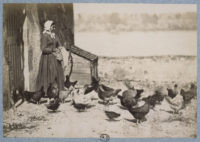 Pioneer woman in chemise and pantalets
Pioneer woman in chemise and pantalets
Contrary to some assumptions about frontier practicality leading to the abandonment of certain garments, corsets were a common element of pioneer women’s clothes. Many women venturing West were driven by aspirations for a better future, be it economic advancement or religious freedom. They were “proper” women who maintained the social norms of their time, and the corset was considered an essential garment for respectability and posture.
While the rigors of daily frontier life might have led some women to loosen or temporarily forgo their corsets for strenuous tasks, it’s evident that corsets were brought West and worn whenever feasible. They symbolized a connection to their former lives and a commitment to maintaining a sense of decorum in their new environment.
Layered over the corset came petticoats, a garment that offered both warmth and shape to the outer dresses. Pioneer women often owned multiple petticoats in varying fabrics and weights. The choice of petticoat depended on the weather and the occasion, ranging from simple cotton for everyday wear to more elaborate options for church or social gatherings. Stockings were another essential undergarment, worn whenever leaving the house or receiving guests. These were typically held up with garters or tucked into the pantalets, a method that might seem less comfortable by today’s standards but was common practice at the time.
Fabrics of the Frontier: Practicality and Availability
Calico emerged as the quintessential fabric for pioneer women’s clothes. Often associated with quaint floral prints, calico is actually a plain-woven cotton fabric, slightly coarser and more durable than modern cotton. Its properties made it ideal for the frontier environment: lightweight yet sturdy, breathable, and relatively easy to clean – crucial factors for women engaged in daily physical labor and facing limited laundry facilities.
While calico is often visualized with small floral patterns, it was available in various dyed options from general stores. Pioneer women also practiced homespun dyeing using both commercially available dyes and natural pigments extracted from plants like leaves, bark, berries, and fruits. This resourcefulness extended the color palette of pioneer women’s clothes beyond what was readily available in stores.
Finer fabrics like cotton and silk were reserved for “Sunday best” dresses and special occasion outfits. Many women brought a few nicer dresses from their previous lives in the East, preserving them for church services, social gatherings, or more formal events in the developing frontier communities.
Access to fabrics varied greatly depending on location and proximity to general stores. While these stores became increasingly common as settlements grew, their availability was not consistent across the vast frontier. In more isolated areas, families often relied on homespun fabrics, a testament to the self-sufficiency and textile skills of pioneer women. The creation of homespun fabrics, however, is a detailed topic deserving of its own dedicated exploration.
Everyday Pioneer Dresses: Functionality Meets Fashion
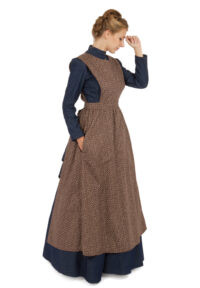 Pioneer woman in daily wear
Pioneer woman in daily wear
Regardless of their backgrounds in the East, pioneer women on the frontier were active participants in establishing and maintaining households and farms. Their days were filled with demanding physical labor – cooking, cleaning, childcare, laundry, gardening, and even field work. The success of frontier families relied heavily on the physical contributions of each member, and domestic tasks were not outsourced. Pioneer women adapted to a life of manual labor quickly, and their clothing reflected these demands.
The general dress silhouettes popular in the broader nation – fitted bodices and full skirts – were maintained in pioneer women’s clothes, but with practical modifications. For daily wear, skirts were hemmed several inches shorter, typically around three inches, to facilitate easier movement during chores and tasks. Some accounts suggest that weights were sewn into the hems of skirts to prevent them from blowing up in the wind and causing immodest exposure, a practical adaptation to the often breezy conditions of the plains and prairies.
Bodices remained fitted, reflecting the prevailing fashion, but sleeves were often looser and extended to the wrists, paired with high collars. These adaptations offered protection from the sun and elements while working outdoors.
Laundering pioneer women’s clothes was a significant undertaking. Regardless of prior experience with domestic chores, frontier women were responsible for washing clothes, often by hand using rudimentary tools and methods. The concept of “wash dresses” emerged, designed for easy care. A popular style in 1867 was a two-piece dress of white cotton with a printed pattern. Its simple construction and washable fabric made it practical for daily wear and readily adopted by women across different socioeconomic levels on the frontier. While further research is needed to fully document “wash dresses,” their existence underscores the rapid adaptation of fashion to meet the practical needs of frontier life.
Sunday Best: Maintaining Social Graces
 Pioneer couple in Sunday attire
Pioneer couple in Sunday attire
While frontier life could be isolating, settlements quickly established churches, and regular church attendance became a vital social norm. Although accounts exist of women in impoverished communities attending church barefoot, it was more common for pioneer women to possess at least one or two dresses specifically reserved for Sundays and church services. Historical records tend to focus on more privileged settlers, making it challenging to definitively determine the most prevalent reality across the diverse frontier communities.
Pioneer women’s “Sunday best” attire closely resembled contemporary fashions in eastern cities. Full skirts, supported by petticoats and corsets, remained the foundation. Sleeve styles reflected current trends, incorporating puffed designs like bell, leg-o-mutton, or pagoda sleeves, depending on the decade. Skirt styles also followed fashion trends, with crinolines, hoops, or bustles being incorporated into Sunday dresses as they became fashionable in wider society.
Color choices for Sunday best dresses varied with age and marital status. Younger women and newlyweds often favored lighter colors, transitioning to darker shades as they aged. Sunday ensembles were completed with the most fashionable hats available, along with kid gloves and low-heeled boots, demonstrating a conscious effort to maintain social graces and a sense of style even in the frontier environment.
Social Occasions: Frontier Festivities and Fashion
Beyond daily life and church, pioneer communities found occasions for socializing. Dances, holiday celebrations, picnics, and community gatherings were common, offering opportunities for recreation and social connection. Just as in eastern cities, pioneer women understood the importance of dressing appropriately for these events.
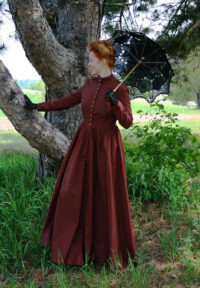 Pioneer woman in church dress
Pioneer woman in church dress
For women with the means, a separate dress was often reserved for social occasions, in addition to everyday and Sunday attire. These dresses were highly valued, and women might order fabrics from general stores and eagerly await the chance to create the latest styles. Godey’s Lady’s Book, a popular women’s magazine of the era, served as a crucial fashion resource. Pioneer women reportedly shared copies and enthusiastically replicated dress patterns and styles featured in its pages, demonstrating a strong desire to stay connected to broader fashion trends.
Fabric availability for social occasion dresses depended heavily on the accessibility of general stores. For many, owning a large wardrobe was not feasible. In such cases, the “best dress” available served for special events, and women employed creative embellishments to elevate their outfits. Hand-crocheted collars, shawls, and other accessories became important tools for adapting and enhancing existing garments for social occasions.
Accessories: The Finishing Touches of Pioneer Women’s Clothes
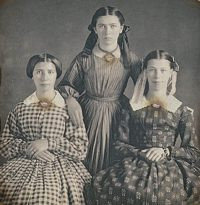 Pioneer girls with accessories
Pioneer girls with accessories
Accessories played a surprisingly significant role in pioneer women’s wardrobes. Beyond the foundational garments and dresses, accessories were vital for adding personal style, practicality, and a touch of refinement to pioneer women’s clothes. Despite the focus on practicality, pioneer women understood the power of accessories to elevate their appearance and express individuality.
Essential accessories for pioneer women included:
- Aprons: Indispensable for daily tasks, aprons protected dresses and often featured decorative elements.
- Boots: Sturdy boots were essential footwear for navigating the varied terrains of the frontier.
- Brooches & Lockets: Jewelry, even simple pieces, added personal touches and sentimental value.
- Earrings: Another common form of jewelry, earrings provided a subtle element of adornment.
- Precious Stones & Metals: While perhaps less common for everyday wear, precious jewelry was cherished for special occasions and represented lasting value.
- Hair Adornments: Ribbons, combs, and other hair accessories were used to style and decorate hairstyles.
- Hats: Hats were crucial for sun protection and were also considered essential for modesty and style when venturing outside.
- Collars & Cuffs: Detachable collars and cuffs allowed for customization and freshening of dresses.
- Gloves: Gloves were worn for warmth, sun protection, and maintaining a polished appearance, especially for church and social events.
- Undersleeves: Removable undersleeves added layers and could be changed to refresh an outfit.
- Parasols: Parasols offered protection from the sun and were considered fashionable accessories.
- Fans: Fans provided relief from heat and added a touch of elegance.
- Handbags: Small bags or reticules were used to carry personal items.
- Shawls: Shawls offered warmth and could be draped for added style.
The Enduring Legacy of Pioneer Women’s Style
Exploring pioneer women’s clothes reveals a fascinating interplay of necessity and fashion. While practicality was paramount, pioneer women didn’t entirely abandon the desire for style and social graces. They adapted prevailing fashions to the demands of frontier life, creating a unique and resourceful approach to clothing. The legacy of pioneer women’s clothes reminds us of their resilience, ingenuity, and determination to maintain their identities and communities while forging new lives in the West.
Embody the Pioneer Look:
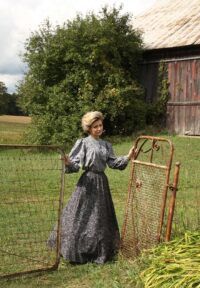 Pioneer woman in blouse and skirt
Pioneer woman in blouse and skirt
Explore our Pioneer Clothing Collection
Pioneer Calico Blouse and Skirt Set
Harper Victorian Pioneer Dress
Pioneer Blouse, Apron, and Skirt Ensemble

